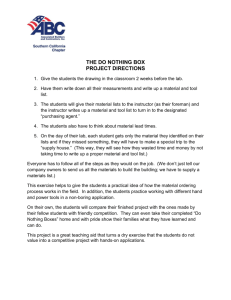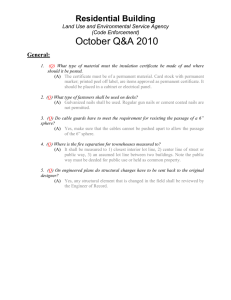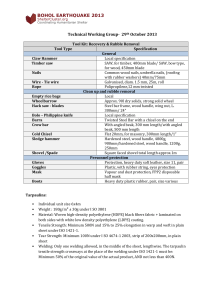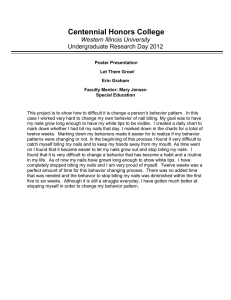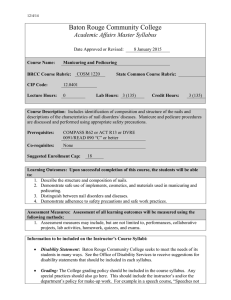FOREST PRODUCTS LABORATORY - Wisconsin
advertisement
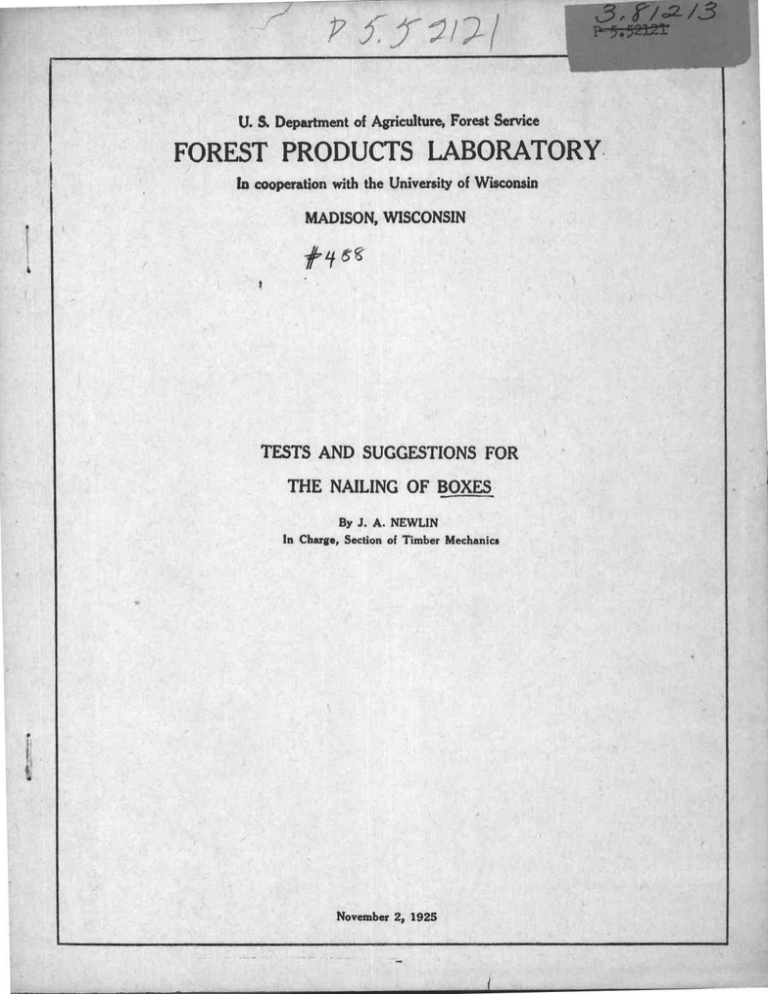
U. S. Department of Agriculture, Forest Servic e FOREST PRODUCTS LABORATORY In cooperation with the University of Wisconsin MADISON, WISCONSI N TESTS AND SUGGESTIONS FOR THE NAILING OF BOXES By J . A . NEWLI N In Charge, Section of Timber Mechanic s November 2, 1925 TESTS AND SUGGESTIONS FOR T} NAILING OF BOXE S By J . A . Newlin * The purpose of nailing a box is to hold it togethe r and give it rigidity . To use more nails or larger nails tha n are necessary to accompiisn this purpose is a waste of bot h material. and labor . To use fewer nails than are necessary t o hold properly under ordinary conditions results in breakage o f the box and damage to the contents . Tests at the Forest Products Laboratory of the Unite d States Forest Service, at Madison, Wisconsin, and observa tion of packages in transit and at their destination have show n conclusively that where the nailing is insufficient, the packag e cannot be improved by putting in heavier lumber . Observation has shown also that the majority of failures in ordinary boxe s are due, not to the lumber, but to the nailing . It is als o evident that in many instances a better package could be obtained with much thinner material by the use of a few mor e nails . In arriving at the proper nailing there are a number of factors that must be considered . These involve th e nail, its length, diameter, and surface, and the species o f wood, its thickness and condition . It is desirable to know whether the nail should b e smooth, barbed, or cement-coated . Our tests have shown tha t at least in the ordinary sizes, barbed nails are not so efficient in box construction as smooth ones. Apparently th e ability of the barbs to increase the resistance of the nai l to withdrawal is more than offset by their tendency to tea r the wood . Cement-coated nails have given uniformly' bette r results than smooth nails, although different lots of cement coated nails have shown greater variation in efficiency tha n smooth nails . The holding power of the cement-coated nai l is from 10 to 30 per cent greater than that of the same size d smooth nail . On an average, a box built . up with the cement coated nails will withstand about one and one-half times as much rough handling as a box made with the same number an d gauge of smooth nails . *In Charge, Section of Timber Mechanics, Forest Product s laboratory, U . s . Forest Service, Madison, Wis . 8488 Length and Diameter of Nail s If the nail is short and is driven into soft woo d the weaving of the box in transportation and shocks due t o rough handling will cause the nail to work back and fort h to its full length in the wood and come loose almost immediately, notwithstanding the fact that it may be of compara = tively heavy gauge . If the nail is very slender it will not drive well , and the longer it is the greater must be its diameter in orde r to insure that it will drive . If a very slender nails i s driven to considerable depth in a piece of hard wood, the shock s of transportation and handling will bend the nail between th e two planks of the box and it may fail by breaking off rathe r than by pulling out . The diameter of a nail should be great enough so tha t it may be driven easily, which is usually the limiting factor , but should not be so small that it will break in use . I t should be such that with the weaving of the package in transportation and the shocks of handling it will not be bent and will not work back and forth to its full depth in the wood . The proper balance is reached when there is an e q ual likelihood of the wood failing or of the nails breaking off or pulling from the end . Head of the Nail As a rule, the head of the nail is too small, an d failures of the box occurs because the head is pulled throug h the sides . With the larger heads made in accordance with th e ordinary practice the material is too thin and the head break s off . It is thought that a much better nail can be made than. is being produced at the present time . The Woo d The species of wood is of importance, since eac h species has certain characteristics of weight and hardnes s which indicate its ability to hold nails, its strength and . its liklihood of splitting, and thus determine the prope r thickness of material and size and spacing of nails . R488 -2 - The most significant difference in the various specie s of wood is in their dry weight ! A piece of lumber of very light weight has but little wood substance . It has been show n that all wood sulbstance is of practically the same weight and that the weight of a piece of dry lumber, when free from resinous material, is an indication of the amount of wood substanc e it contains . It will be evident, therefore, that without sufficient wood substance it is impossible to have strength o r nail-holding power, and that the more wood substance there i s in a given species the greater its strength and nail-holdin g power are likely to be . Figure 1 is a curve in which has been plotted th e density or dry weight of the various species against thei r ability to retain nails driven into side grain . In this connection it may be noted that, with practically all species , the resistance to withdrawal is greater if the nail is drive n into the side grain than if it is driven into the end grain . The curve shows conclusively that the heavier species hol d nails-much better . As a rule all the strength properties o f wood increase with the weight . When a nail driven into a dense piece of wood it produces a much greater splitting forc e than when the same nail is driven into a soft piece of wood . A dense piece of wood has greater resistance to splitting tha n a light piece of wood . These two factors tend to epunterbal ance each other but do not do so entirely . The dens e species, as a rule, will split somewhat more than the lighter species with the same nailing . is The lockiness of grain and other species characteristics are important factors in determining the resistance t o splitting . Condition of Woo d Green wood is much softer than dry wood, and th e nails can be driven in and withdrawn from green much mor e readily than from dry wood . The moisture content of wood, when green, may var y from 30 to 200 per bent of the dry weight, depending-on th e species and on conditions of growth . As the wood dries i t first loses the free water in the cells and afterwards tra c from the cell walls . When the water begins to leave the cel l walls the wood be.gins to shrink in both width and thicknes s but not materially in length . This causes the fibers whic h R488 -3- are ,bent dovsnralong the nail, as illustrated to shrink awa y TTh ; ---_ from the nail in the direction of the end grain, _in ..which. dir ection the nail• was being most firmly held in the first place . Thus we have the . nail which has been driven into green material , afterwards drieds held only by two sides . The weaving actio n during . transportation will readily cause such nails to come loose and work out of the box without any . rough handling, and the bpxes will not stand - more than l0 . per cent as much rough handling as those nailed up at 15 per cent moisture and kep t in practically that condition . A nail driven into a dry piece of wood which after wards is allowed to become soaked and then dried will act a s does a nail driven into green lumber . Boxes made of lumber in the prover moisture conditio n will stand ordinary storage without any appreciable loss in the ability of the nail to hold . The effect of over-driving nails is to reduce thei r resistance to withdrawal, the proportionate reduction probabl y being greater in the . case of dry wood than in green . . Thickness of Material and Spacing of Nail s After the above fundamentals as tp nails and wood , consideration should,be given to the thickness of material and the spacing of nails . R488 -4- The ends of the bo-xes_ must be of -sV h thicknes s that the nails will not run out under ordinary conditions . The nails must be small enough in diameter so that the y will not cause splitting of the material . The inclinatio n to split is increased with decreased spacing . The spacing , then, .must not be so close as to cause splitting . Experiments have been made and a great many observations taken on the splitting of material by nails . The following conclusions have been drawn and appear to be substantiate d by two years of observation : In using the cooler or sinker in species of medium hardness, the "penny" of the nail cannot be greater than th e thickness, in eighths of an inch, of the wood which holds th e point of the nail . For the softer woods nails may be one "penny" large r and sometimes even two "pennies ." For the hard wood nails on e "penny" smaller should be used . The ordinar box machine, when nailing boxes of th e sizes usually used for canned foods, cannot space the nail s close enough to cause splitting of the ends or to develo p the strength of the lumber . The following rule has been suggested for guidanc e in the spacing of nails for domestic shipment . For six "penny" or smaller nails held in the sid e grain, there should be a spacing of 2 inches, and for th e same nail in the end grain a spacing of 1-E; /4 inches . For larger nails, the spacing should increase 1/4-inch for eac h "penny :" To a great many people, this spacing will appear t o be too close, since it gives many more nails than have formerly been used . As a matter of fact, however, i t is only abou t two-thirds of the number that can be put in before excessiv e splitting of the ends is encountered, and is only about two thirds of the number re ; aired. to balance fully the strength o f the box in other respects . Therefore, even with this spacing , which is shown on the attached schedule, the nailing is stil l the weakest point of the ordinary box . Proposed Schedule for oiling Boxe s The gauge of nails to be used is determined by th e thickness and species of the wood in which the POINTS of th e nails are held after driving . The following schedule is base d upon standard cement-coated box . nails . If the designate d penny of the nail is not available, use the next lower penny and space nails proportionately closer . R488 -5 - Spacing of Fails When nails are 6d or less space those holding boards to end grain of end 1-3/4-inch apart, and holding boards to side grain of end 2 inches apart . Increas e spacing of nails 1/4-inch for each penny over 6 . No board should have less than 2 nails at each nailing end . When nails holding top and bottom to sides are specifie d they should be spaced 6 inches or more apart when nails are 6d or less, increasing the spacing 1 inch for eac h penny over 6 . 150 r d r d 'd r d r d (23~15o r-r- c> 5 0 +? 'D . H co H a) Fwi rd to P, rd rd rd r---N-ko q • •r l o •H H''---. H or n rd 150 rd rd rd .o lfl_'f• r--\ 0 P4 _ 41 cd O 0 o H .'o \ o• co a rd ) tt i H o a) w as a) to s~~ o H + LLC\ LC\z rd rid rd rd L(l Lfl- h 't 'd d d r~ N- 4• 03 -p ▪ to w co M 0a 4.4 q o a) m o Pi C') tO a 4+3 ,o 41 U) •r1 4-) o rd cd ri 4.1 0 0 `~ H H a) + rdEaO cd 0 z r i rd rd d .*-rnrn . . • ' w .-. I of f O q rd F." ~ ~ •rl rd a) 4-1 o cd to m Pr~ to H e. w O CO O rrdl 0000 rC rd cd a) O H O ad a) 4-4 • H HH H H Pi P, A bD 0 0 C3 C'3 0000 co a) • .rr4 w H !a, o o a o w •rl •rl a) •r1 ' a oa)kow a H • c +'r +' ~H H •r•1 H H 'd w bli CO o •rI 0 0 (4 co co lm OQ o a) R • OFf lg m CO • ,o Co Oma) +3 M a) a i )H cd •H R + •ri 0 •ri 4i PL. A, H r. a)a)oa)cd ho 0 H () •4 00 0 oP.Cd0 o m ~ H o a) o (D • 0 as a) +' • w +-I as P1 U 0 +3 0 • +3 +4 0 r-4 a) N 3 o co rd + w 0 O Uri to Q, O al MI • q f a) H ~,' ..-r4 -H cd H cn U) co H q a) •ri 4 co o CO U) Q •r•1 H ati 0 ~, 0•r+ wuax x cd H . co a) 0 0 k a) r1 • •r 1 a)co ca m a) a) In CD k ra rd d d 1--l O -p o 1 .o TO NA-0 LC\ H o „5., to a) a) .o co w w o 1~ •rIa)m CD H to cd a'i ~C P4 cd lx m tf) a a~ .t t.. u .c i~ a Ea v a+ 0 C~`~ y m 01 u m 0 4 m m a o ~ 0 0 o
